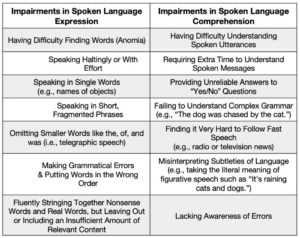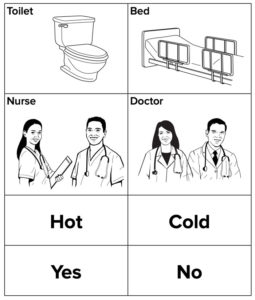22 Apr What is Aphasia?
Aphasia is a condition that encompasses both expressive (verbal output) and receptive (understanding the words of others) language impairments due to stroke, brain tumor, or other traumatic brain injury.
Expressive Aphasia
Expressive language impairments may range from minimal word finding difficulties during conversational speech to severe impairment characterized by a complete lack of ability to express wants/needs or simple thoughts. Examples of expressive language impairments may include:
- Inability to identify the name of familiar items and what they’re used for;
- Difficulty remembering names, including those of family members; and
- Challenges with expressing simple ideas.
People struggling with Expressive Aphasia may substitute one word for another or say unrecognizable words. This impairment may also extend to the inability to recognize letters, words or numbers. The person may speak in short or incomplete sentences or speak in nonsense phrases or sentences. In severe cases of Aphasia, the person may not be able to express even their most basic needs or wants. At any level of expressive language impairment, a person dealing with this disorder may suffer from feelings of frustration and isolation due to the breakdown in their communication.
Receptive Aphasia
Receptive Aphasia is characterized by the inability to understand what is being said to them in conversations or through simple instructions. They may have trouble answering simple yes or no questions, such as, “are you sitting in a chair.” They may also have difficulty in following simple instructions such as, “sit in your chair” or “use your walker.”
Global Aphasia
In significant cases of Aphasia, the person may have what is known as Global Aphasia which includes a combination of both expressive and receptive language impairments. People who suffer from Global impairments may be unable to say or write understandable words or understand what is being said to them.
Some tips to improve your communication with someone who has Aphasia include:
- Speak slowly and break down your sentences into single thoughts
- Look for easier ways to approach tasks for someone with Aphasia
- Understand that an inability to speak is not a sign of poor intelligence
- Be patient with responses, even when they stumble over their words
Aphasia Speech Therapy
It is the role of the Speech/Language Pathologist to assess a person’s level of impairment and design and implement a set of goals to address those deficiencies. As with any therapy, development of good rapport between the therapist and patient is the first step in creating a good working relationship effective speech therapy program. It is important to begin therapy as soon as possible after the injury has occurred. At the beginning of each therapy session, therapeutic tasks are performed at an easy-to-accomplish level. The tasks then must challenge the patient to move beyond what they are currently able to do and expand their ability to recognize new words and put together sentences.
For a patient who has severe expressive impairment, a communication board may be useful. The typical communication board may consist of pictures to express feelings, wants, or needs. It may also include simple words or pictures of familiar items. These may be very helpful to caregivers in attempting to meet the needs of their patients.
For a patient with Receptive Aphasia, goals must be geared toward assisting the patient in understanding simple statements or instructions to more complex conversation. If the patient is able to read, having short, simple sentences or instructions written on a white board is often helpful. Therapy sessions are concluded with tasks that the patient can accomplish, thus ending the session on a positive note.
It is estimated that over 1 million people in the United States are living with Aphasia. Difficulty communicating with others can lead to isolation and depression. The goal of Speech Therapy, no matter what the level of impairment, is to improve communication efforts at every level.



